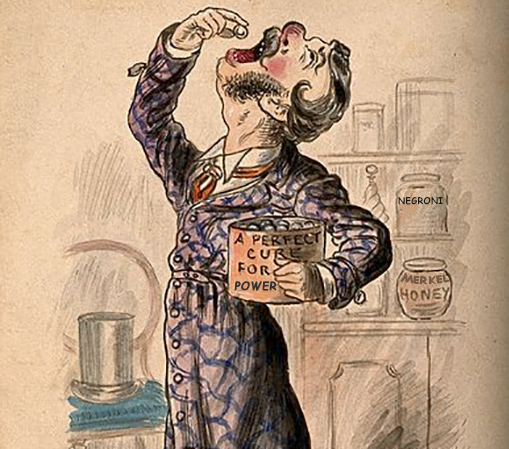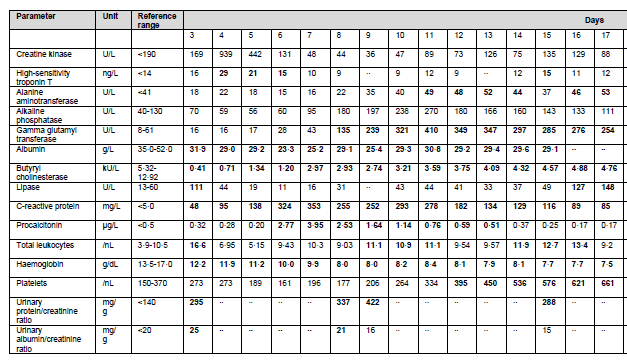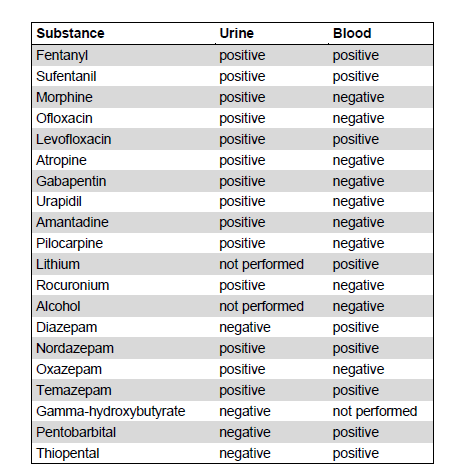

by John Helmer, Moscow
@bears_with
The German laboratory test results for Alexei Navalny, published by a group of doctors at the Charité – Universitätsmedizin Berlin last month, reveal a surprising number of medical symptoms, but they are not those of Novichok nerve agent poisoning as Navalny and his supporters in western governments have alleged.
Clinical doctors, toxicologists, and pharmacology experts outside Germany believe the test results which the Charité group released on December 22 reveal symptoms of acute pancreatitis, diabetes, liver failure, severe dehydration, muscular rigidity, as well as a serious bacterial infection, and a possible heart attack associated with his kidney problems. According to the experts, these are not recognisable symptoms of a nerve agent attack.
The German medical publication reports Navalny’s “laboratory values on admission”, and toxicology and pharmacology results “in blood and urine samples obtained on arrival of the patient of the patient at Charité – Universitätsmedizin Berlin (day 3)”. Accordingly, the newly available data are evidence of the condition Navalny was in during his two-day treatment in Omsk Emergency Hospital No. 1 in Russia; and of the treatment he received there, as well as during his six-hour flight on a German medical evacuation aircraft from Omsk to Berlin.
The German doctors have also released a tabulation of their laboratory test results for Navalny during 33 days of his stay in the Charité hospital, and a subsequent visit to the hospital as an outpatient. The four data tables are described by the Germans as following “the supposed poisoning of the patient”. The doctors don’t wish to sign their names to this “supposing”.
Navalny first fell ill on the morning of August 20, during a flight from Tomsk, where he had been on an election campaign tour, to Moscow. The flight was diverted to Omsk, and Navalny admitted to hospital in Omsk in mid-morning local time. He was in intensive care there for 48 hours until he was released for German medical evacuation to Berlin on August 22.
The German doctors treating Navalny at the Charité were led by Kai-Uwe Eckardt, the chief of the Charité treatment unit whom Navalny publicly thanked on October 7. Eckardt and David Steindl are the principal authors of the December 22 report; Eckhardt is a specialist on diabetes and kidney transplants; Steindl is a specialist on musculo-skeletal pathologies.
Read their report in the British medical journal, The Lancet, here. A forensic analysis of the report can be read here. This exposes the many contradictions between the medical evidence now attested by the Germans and the allegations from Navalny and his supporters.

Kai-Uwe Eckardt and David Steindl
In their 4-page case report, Eckardt and Steindl say “severe poisoning with a cholinesterase inhibitor was subsequently diagnosed”, not by the Charité group, but by a “laboratory of the German armed forces”; that was the Institut für Pharmakologie und Toxikologie der Bundeswehr (IPTB).
British toxicologists have repeatedly cautioned there can be many causes and sources for the cholinesterase inhibition detected from metabolites in Navalny’s blood and urine, and they continue to ask the German doctors and the IPTB: “Name the compound. That would be a good start.” In their publication of Navalny’s test results, Eckardt and Steindl say: “results of toxicology analyses conducted in a special laboratory of the armed forces [IPTB] are not included.” They don’t give a reason.
In the Lancet case report, there are several references to a 4-page appendix. This contains Navalny’s test results, but the appendix is not easy to find and was published separately. The Lancet editors explain: “this appendix formed part of the original submission and has been peer reviewed. We post it as supplied by the authors.” It can be opened and read here.
ALEXEI NAVALNY’S LABORATORY TEST RESULTS ON ARRIVAL IN BERLIN

Source: https://drive.google.com, Appendix S1.
A review of these data by a clinician with specialised training in pharmacology provided a detailed interpretation of each line of data where the reported value for Navalny was either well above or below normal.
The expert, who declines to be identified, reports that the sodium and chloride scores show Navalny was suffering from extreme dehydration on his arrival in the Berlin hospital. How this was possible after the German medevac flight is unknown.
The spikes in the tested creatine kinase-MB and myoglobin reveal that his muscle function was breaking down; the visible symptom, according to the expert, should have been muscle rigidity. According to the German doctors, they didn’t see it, and neither did the Omsk hospital doctors, or witnesses of Navalny’s collapse on board the flight from Tomsk. The German case report, quoting from the Omsk hospital “discharge report”, says “the patient presented [in Omsk on August 20] comatose with hypersalivation and increased diaphoresis [sweating].” When Navalny reached the Charité, the doctors there reported in December, he was “deeply comatose, with mild bradycardia…hypersalivation, hypothermia (33.5C), increased diaphoresis and small pupils not reactive to light, decreased brainstem reflexes, hyperactive deep tendon reflexes, and pyramidal signs.”
The independent expert does not know how hyperactive tendon reflexes can have produced the abnormal MB and myoglobin test results.
The expert said the standard diagnosis which follows from the reported albumin result is chronic disease of the liver. The high lactate dehydrogenase (LDH) score indicates metabolic disorders commonly seen with cancerous tumours. The amylase and lipase results signify pancreatitis, a condition which the Russian press has reported Navalny to have experienced in the past. The results for C-reactive protein, leukocytes, neutrophils, and erythrocytes all point to a serious bacterial infection. The German case report confirms that skin and rectal swabs and urine samples found staphylococcus aureus and other infectious bacteria which were treated with antibiotics, the standard procedure. How Navalny picked up the bacterial infection, and where – in Tomsk, Omsk, in the medevac flight, or in Berlin – is unknown.
ALEXEI NAVALNY’S LABORATORY TEST RESULTS DURING HIS BERLIN HOSPITALISATION — EXCERPT

Source: https://drive.google.com/, Appendix S4. The table extends to Day 33 in hospital, and includes Day 42 when he returned for testing as an outpatient.
The unusually high result for the urinary protein/creatinine ratio has been diagnosed by the expert as signifying kidney failure – “clinical diabetes but not an extreme presentation.” Diabetes has been reported for Navalny in the past; his staff deny it.
The abnormally high troponin-T results reported on Days 4 and 5 at Charité are puzzling to the independent expert because they signify a heart problem or mild heart attack, possibly related to the reported kidney failure. Eckardt and Steindl say in their case report that Navalny’s heart was beating abnormally slowly (bradycardia – 44 beats per minute) when tested in Omsk hospital, then 59 beats per minute during the flight to Berlin. After he arrived at Charité the bradycardia worsened to 33 bpm.
The independent expert accepts that the unusually low test score for butyryl cholinesterase – 0.42 on arrival in Berlin, 0.41 at Day 3 – usually signifies exposure to a cholinesterase inhibitor. The German doctors’ report says: “based on clinical and laboratory findings, severe cholinesterase inhibition was diagnosed and the patient was started on atropine and obidoxime…Cholinergic signs returned to normal within 1 h[our] after the onset of this antidotal therapy.” The German test results do not substantiate this conclusion, neither for troponin-T which didn’t normalise until Day 7, or butyryl cholinesterase, which didn’t reach normal until Day 17.
Testing for cholinesterase inhibition is the key to the allegations of the German Army laboratory, the German intelligence agency BND, and German officials that Navalny had been poisoned by a Russian Novichok nerve agent. The new data disclosure falls short of proof. Instead it reveals that in Berlin Navalny’s laboratory testing showed cholinesterase inhibition, while in the Omsk hospital laboratory reports published in part in August, revealed that “cholinesterase inhibitors were not detected in blood and urine”; for more details of the earlier test data, read this and this.
This week the independent expert also reviewed the table of medications which testing of Navalny revealed on his admission at Charité:
ANAESTHETIC AND ANTIDOTE DRUGS NAVALNY WAS GIVEN IN OMSK AS TESTED IN BERLIN

Source: Appendix S2. https://drive.google.com/
According to the source, the presence of pain relieving and anaesthetic drugs, antibiotics, and atropine are conventional treatment. Amantadine is a neurological drug often used in treatment of Parkinson’s Disease; lithium is a psychiatric medication for treating bipolar mood disorders and depression. Lithium, the expert says, along with the relaxant drugs recorded in Navalny’s system — diazepam, nordazepam, oxazepam — are commonly taken orally. If Navalny had been comatose at Omsk hospital and then at Charité, then it is likely he took these drugs himself in Tomsk before his flight. The Omsk hospital testing also reported that Navalny had taken “tricyclic antidepressants” before his collapse.











Leave a Reply